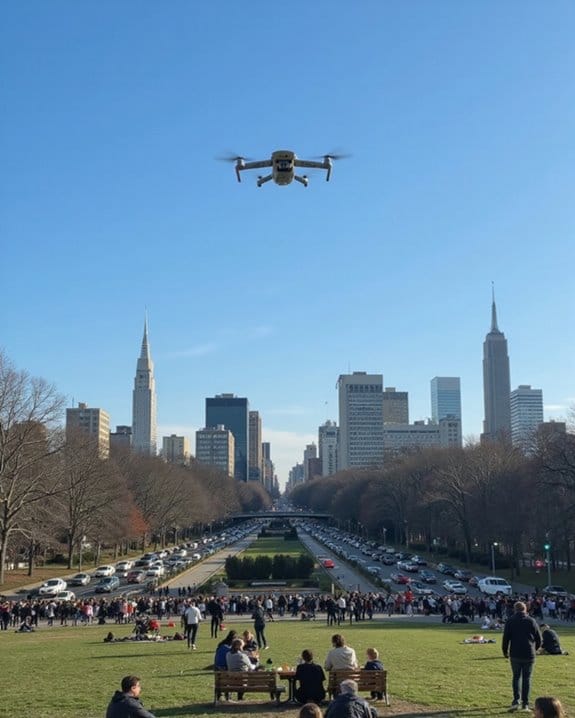When you wonder why no one seems to act on drone safety, it’s really that action happens behind the scenes. Federal agencies—like the FAA, FBI, and DoD—log and investigate thousands of drone incidents yearly, quietly ramping up advanced tracking tech and stricter enforcement. Arrests do happen, and new rules are in the works, but most drones belong to hobbyists or businesses, not spies. If you’re curious about real solutions, just keep going for up-to-date insights.
Key Takeaways
- Most drone sightings are linked to hobbyists or commercial users, not serious threats, so authorities see limited need for sweeping action.
- Federal agencies have investigated thousands of reports but found no evidence of national security or public safety threats.
- Legal and regulatory frameworks exist, but enforcement and identification of drone operators remain challenging.
- Advanced detection technologies are being deployed, but implementation and coordination across jurisdictions take time.
- Privacy and noise concerns are noted, yet current policies prioritize commercial innovation over imposing stricter restrictions.
Understanding Recent Drone Sightings Across the U.S
A surge in drone sightings across the U.S. has everyone—from hobbyists to federal agencies—paying close attention to the sky. You’ve probably noticed that reported drone sightings have increased, especially in places like New Jersey, where authorities logged 12 incidents in just one Saturday. These unmanned aircraft come in all shapes and sizes—some are as wide as six feet, and most take flight after dark.
Key Details:
- Over 5,000 drone sightings reported since November 2024.
- Hotspots include New Jersey, New York, and Ohio.
- Drones spotted near military sites and airports.
- Nighttime flights, often loud and bright.
Practical Takeaway:
If you spot a drone, document the time, location, and any distinguishing features. Not every unmanned aircraft is a cause for alarm, but vigilance doesn’t hurt. Many security experts recommend using anti-drone devices to detect and mitigate potential threats effectively.
Assessing the Real Threat: What the Government Says

Curious about whether these drone sightings signal real danger or just aerial curiosity? Here’s what the government says. According to the Department of Homeland Security and the Federal Aviation Administration, there’s no evidence that these sightings pose any national security or public safety threat. In a recent joint statement, agencies including the DHS, FAA, FBI, and Department of Defense clarified:
- Most sightings are linked to commercial, hobbyist, or law enforcement drones.
- Some reports actually involve manned aircraft—or even stars!
- The FBI has received over 5,000 reports but found no foreign connections or malicious intent.
Experts recommend choosing drones with automated safety features to ensure responsible operation and minimize risks.
Who’s Flying These Drones? The Mystery of Unknown Operators

So who’s really behind these mysterious drone flights? With over a million drones registered in the U.S. and about 8,000 in the air each day, it’s tough to pinpoint every operator. Federal investigations by agencies like the FBI and Department of Homeland Security haven’t identified foreign involvement—so you can probably cross off Russia and China from your suspect list.
Here’s what you need to know:
- Operators could be hobbyists, commercial users, or even law enforcement on legitimate business.
- Authorities admit they still don’t know who’s responsible for many recent sightings in places like New Jersey.
- The Pentagon notes these drones are too noisy and bright for covert spy work.
Bottom line: With so many drones buzzing around, identifying every single pilot is no simple flight path. Many certified pilots maintain FAA Remote Pilot certifications ensuring safety and professionalism in drone operations.
Arrests and Incidents: What Happens When Drone Laws Are Broken
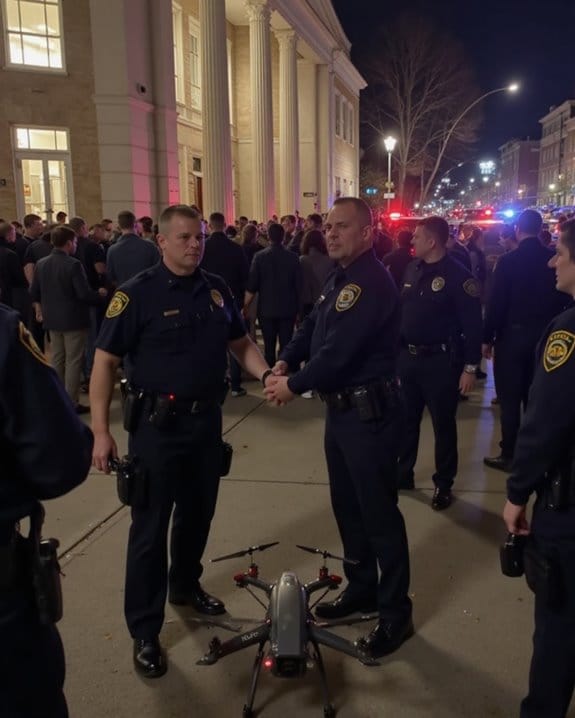
Ever wondered what actually happens when drone pilots cross the line? When you break the law by flying drones in restricted zones, it’s a serious matter for security and public safety. Let’s break down what occurs:
Key Incidents and Responses:
- Arrests: In Boston, two men were arrested for flying drones near Logan Airport, facing trespassing and hefty fines.
- Security Measures: At Wright-Patterson Air Force Base, drones triggered a four-hour airspace closure—security protocols activate immediately.
- Operational Disruptions: Stewart Airport in New York shut down for an hour after drone sightings, showing real-world impact.
- Investigations: In Massachusetts, a swarm of drones over homes led to FBI involvement, highlighting strict law enforcement.
Bottom line: If you ignore drone laws, expect legal action and serious consequences for public safety.
Drone Sightings Near Sensitive Locations: Should We Be Worried?

After looking at what happens when drone laws are broken, you might wonder about the risk posed by drones spotted near places like military bases or government sites. Recent reports highlight dozens of drone sightings near the Picatinny Arsenal, Donald Trump’s golf course, and other locations involved in military research and manufacturing. Should you be worried?
Let’s break it down:
Key Facts:
- Most sightings are commercial or hobbyist drones, not threats.
- The Biden administration found no national security or public safety risks.
- Federal agencies confirmed no foreign involvement—these aren’t spy gadgets from Russia or China.
- Even incidents that closed airspace, like at Wright-Patterson, didn’t impact facilities.
- Out of 5,000 reports, only 100 warranted investigation and none posed real danger.
In short, drone sightings near sensitive sites rarely mean trouble—for now.
How Federal Agencies Are Responding to Drone Activity
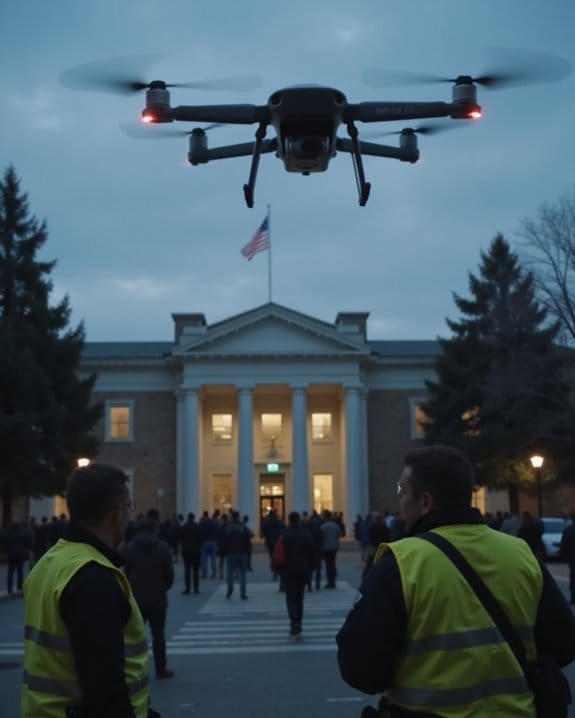
How exactly are federal agencies tackling the uptick in drone sightings near sensitive sites? You’ll find the federal government is coordinating a multilayered response. Here’s how it breaks down:
Overview:
- Agencies like the DHS, FBI, FAA, and DoD jointly assess reports—over 5,000 so far—with no evidence of anomalous drone threats.
- The FBI generates leads and investigates, but hasn’t found foreign involvement.
Technical Analysis:
- Most sightings are traced to lawful commercial or hobbyist drones, or even misidentified objects.
- The DoD equips state and local law enforcement with advanced detection tech, especially near military facilities.
Practical Guidance:
- State and federal teamwork is essential. For example, joint efforts led to temporary airspace closure at Wright-Patterson AFB.
- Recommendation: Stay informed; most drone activity is harmless, but report suspicious cases for prompt response.
The Debate Over State and Local Authority on Drone Regulation
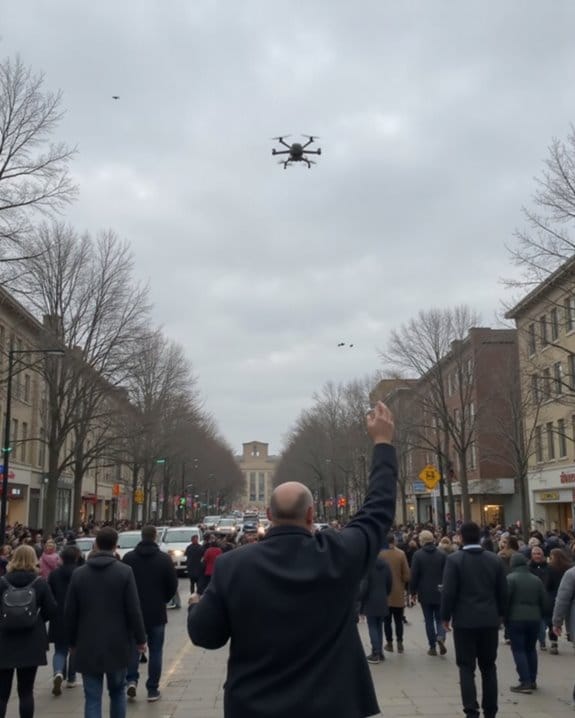
When it comes to who should call the shots on drone regulation, the debate is anything but grounded. Should federal agencies set all the rules, or should state and local governments have more say? Here’s a quick breakdown:
State and Local Authority:
- New Jersey’s governor wants states to have more legal muscle when drones threaten airspace.
- A Senate bill proposes pilot programs giving state and local law enforcement the right to disrupt or seize risky drones.
- Lawmakers like Blumenthal and Smith argue for expanded local law enforcement powers in drone investigations.
Federal vs. Local:
- Federal agencies support giving state and local authorities better detection tools.
- However, there’s tension over how much power local law should have versus national standards.
For you, understanding these lines of authority is essential before flying or regulating drones locally.
Advances in Drone Detection and Tracking Technology
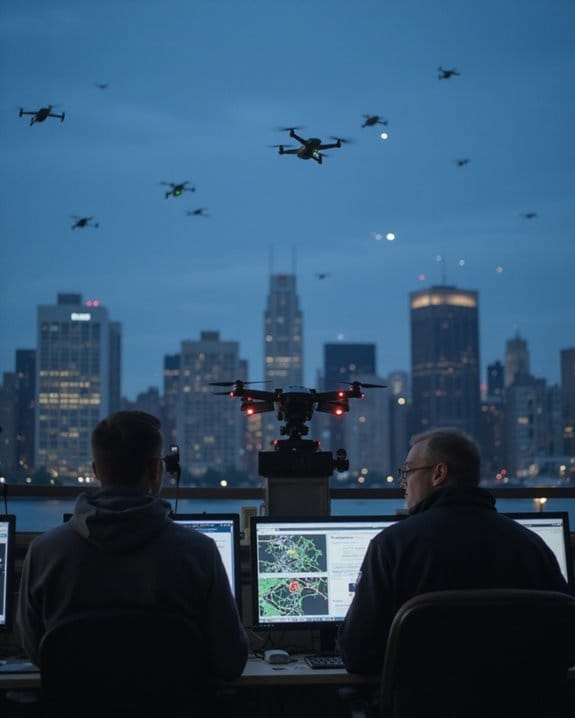
A new wave of drone detection and tracking technology is reshaping how authorities monitor the skies—and it’s more than just high-tech binoculars. Today’s advanced systems combine radar, radio frequency sensors, and AI-powered analytics to pinpoint rogue drones in real time.
Product Overview:
- Federal Rollout: Agencies like DHS and FBI are distributing advanced detection tools nationwide for enhanced drone tracking.
- Senate Pilot Program: Proposals include anti-drone measures, leveraging tracking technology for disruption and seizure.
- Military Upgrades: The Department of Defense uses sophisticated detection systems, especially at sensitive sites.
- Real-World Use: In Boston, authorities tracked and arrested drone operators near airports, showing just how responsive these systems can be.
Recommendation:
If you’re responsible for critical infrastructure or event security, consider integrating multilayered drone detection—these advanced systems can turn potential threats into manageable blips on your radar.
Privacy Concerns and Public Perception of Drones
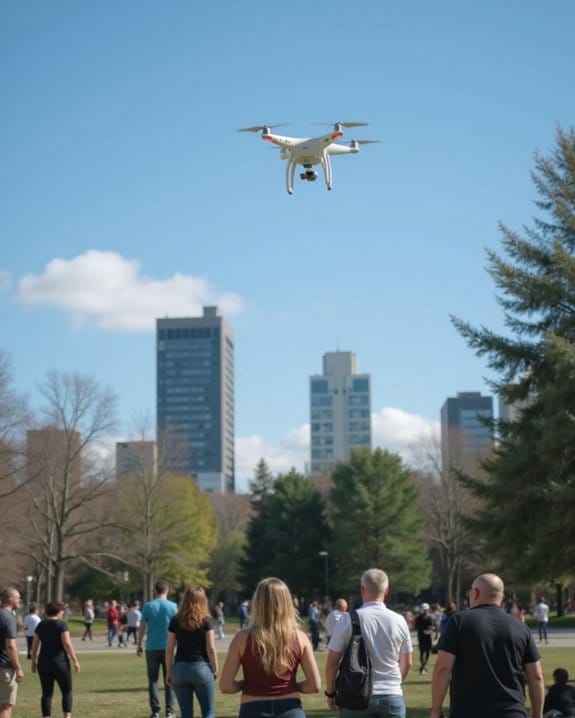
With drone detection tech keeping unauthorized flights in check, it’s only natural for questions about privacy and public trust to come into focus. In the United States, public perception is shaped by how drone companies handle your data and property. Most drone delivery terms of service require you to consent before drones descend over your home, so you’re not caught off guard. Major players like Starbucks avoid privacy concerns by using public drop points, not your backyard. Some systems use docking stations on public infrastructure, keeping drones away from private spaces. Legally, the 1989 Florida v. Riley ruling places drones at 400 feet in public airspace, clarifying boundaries. While privacy dominates headlines, it’s not the main obstacle—commercial operators like UPS and Amazon are already handling these issues.
The Future of Drone Legislation and Safety Standards
Drone legislation’s next chapter is already in the works, and it’s got the potential to reshape how you interact with unmanned aircraft—whether you’re a hobbyist or a business owner. New Senate bills propose enhanced tracking and even the potential for authorities to disrupt, disable, or seize drones. If you’re flying near a research and manufacturing facility or, say, President-elect Donald Trump’s golf course, expect stricter standards and advanced detection technology.
Key Developments:
- Federal, state, and local authorities will get greater powers.
- Detection and mitigation tech is coming to sensitive areas.
- Part 135 certificates (used by UPS, Amazon) are evolving with safety in mind.
Recommendation:
Stay informed as Congress eyes counter-UAS expansion in 2025. If you’re in commercial drone delivery or near restricted zones, anticipate tighter protocols and prepare now.
Frequently Asked Questions
Can the FAA Shut Down Drones?
Yes, the FAA can effectively shut down drones that break regulations. You’ll find they use fines, operational restrictions, and work with law enforcement to seize or disable drones, especially when safety or security is threatened near airports.
Should We Worry About the Drones?
You really don’t need to worry about the drones right now. Most sightings turn out to be harmless—just hobbyists, commercial flights, or even mistaken identities. There’s no evidence suggesting they’re a threat to your safety or security.
What Is the FBI Warning About Drones?
You’re being told by the FBI that there’s no current threat from drone sightings. They want you to know most drones are harmless—used by hobbyists, businesses, or law enforcement—and there’s no evidence of foreign or malicious activity.
What Happens if I Fly My Drone Above 400 Feet?
If you fly your drone above 400 feet, you’re breaking FAA rules. You risk fines, possible criminal charges, and confiscation, especially near airports or controlled airspace. Authorities could investigate, and commercial operations might lose their licenses.

